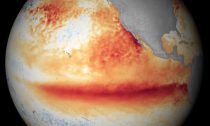
The World Meteorological Organization says there’s a 75-80% chance of a weak El Niño forming within three months. The naturally occurring event causes changes in the temperature of the Pacific Ocean and has a major influence on weather patterns around the world. It is linked to floods in South America and droughts in Africa and Asia.
El Niño events often lead to record temperatures as heat rises from the Pacific.
According to the WMO update, sea surface temperatures in the east-central tropical Pacific have been at weak El Niño levels since October. However the atmosphere has not yet responded to the extra warmth that’s produced by the upwelling seas.
Scientists have been predicting the likelihood of a new event since May this year, with confidence increasing.
The Australian Bureau of Meteorology are now estimating that an El Niño event will start in December. US forecasters are saying there’s a 90% chance of the event starting in January.
The WMO models are say that a fully fledged El Niño is estimated to be 75-80% likely between December and February 2019.
At this point, the WMO says its predictions for the event range from just a warm-neutral condition through to a moderate strength event with sea surface temperatures peaking between 0.8C to 1.2C above average.
The chance of a strong event are currently low.
“The forecast El Niño is not expected to be as powerful as the event in 2015-2016, which was linked with droughts, flooding and coral bleaching in different parts of the world,” said Maxx Dilley, director of WMO’s Climate Prediction and Adaptation branch.
“Even so, it can still significantly affect rainfall and temperature patterns in many regions, with important consequences to agricultural and food security sectors, and for management of water resources and public health, and it may combine with long-term climate change to boost 2019 global temperatures,” he said.
In terms of food security, the UN’s Food and Agriculture Organization (FAO) have issued a report detailing the countries that could suffer food shortages as a result of the event.












Social Profiles